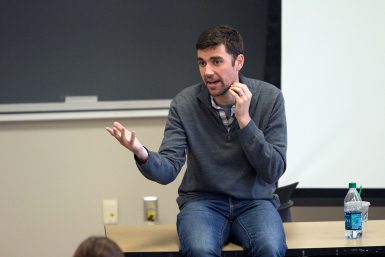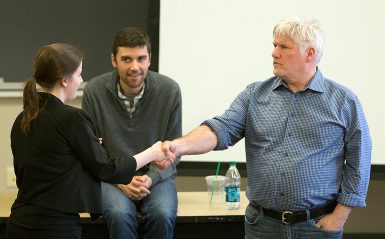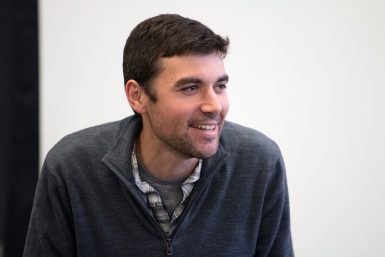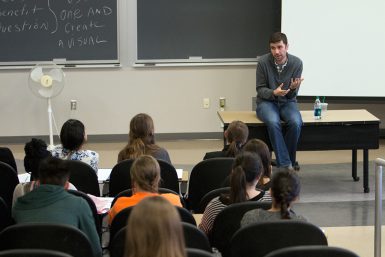Pulitzer winner Eli Saslow explains what makes feature stories shine

Pulitzer Prize-winning reporter Eli Saslow spoke with students in a relaxed Q&A Wednesday about the nature of in-depth feature writing and nailing visceral, telling detail in stories that matter.
Saslow is the latest in a series of award-winning journalists to visit professor of practice Tom French’s Behind the Prize class. All the journalists who visit have won or been finalists for journalism’s top awards.
Saslow, a reporter at The Washington Post, won the Pulitzer in 2014 for explanatory reporting in a series about the prevalence of food stamps in post-recession America. As a Washington Post national feature reporter, he said he writes “stories about people you never heard of in their toughest moments,” such as a Newtown family after the shooting, immigrants deported away from their families and families dependent on food stamps for survival.
But his path to a Pulitzer started with high school sports. After Saslow graduated from Syracuse University 11 years ago, he worked a sports writer focused on high school volleyball. He discovered that a lot of the lessons he learned following sports are applicable across all forms of journalism, especially once his editors asked him to cover politics during the 2008 election season.
He quickly noticed stark similarities between the two beats.

“Politicians and athletes are both people who have some ego, are hard to access and care about winning,” Saslow said. “Writing for sports taught me to look under the surface to tell you what the story is really about.”
Sports coverage naturally contains a lot of dialogue, emotion, tension and scenes between characters. Reporting on games taught him how to write quickly, too.
“If you know how to tell a good story in one thing,” he said, “you can tell a story in just about anything.”
Throughout the class, Saslow outlined some of the most important parts of powerful storytelling.
For starters, a good story has a “quality of the universal — something all people can relate to,” he said. To make sure his sports stories passed this bar, he’d often show them to his wife, who he said is utterly uninterested in sports. If she found the story interesting, it was proof that he did his job.
But the key to making people understand and ultimately care often lies in finding the central theme.

As an example, Saslow talked about one of his latest stories, a feature for ESPN on major league pitcher Daniel Norris, one of the most promising new pitchers for the Toronto Blue Jays who happens to live in a camper in a Walmart parking lot. Saslow spent two days with Norris in his Westphalia van.
Norris is from a small town in Tennessee and signed to the Toronto Blue Jays for millions of dollars. But the money kind of scared him, Saslow said.
“He’s a full person, not just a pitcher,” he said. “He’s a guy who has a lot of money and fame trying to hold onto what is important to him.”
The lifestyle often pressures players to live a certain way, but Norris was determined to live on his own terms — a theme that makes people care because it is so universal, Saslow added.
These themes can be uncovered only by spending times with sources.
“I sometimes try to explain to my non-writer friends what I do, and they’re often like, ‘That’s so creepy. You just hang out in the back of people’s cars and whatever?’” he said.
For many of his stories, yes, that is exactly the kind of work feature writing entails. But it isn’t necessarily about the quantity of time. Quality is key. If you pay close attention and the time is right, he said, you can learn more in three hours than you would in two days.
Eventually, all reporters must sit down and write. Writing is a different process for everyone, but at the end of the day, it’s an earthly practice born of hard work.

“There’s a lot of magic in writing,” he said, “but it’s not a mystical process.”
After the Q&A session, Saslow helped students drill down a good story idea through a brainstorming exercise. He led the students in focusing on one big idea — abortion — and breaking it down into smaller and smaller chunks, such as recent changes in laws or access in geographic regions. They came up with ideas to localize the issue by focusing on one person or group of people in a single place, such as a clinic in a remote town or a busy clinic in a metro area.
Students commented on his candor and willingness to go far for his stories.
“I most appreciate his balance of caring so much and putting himself in these situations, but also still maintaining his ethics and professionalism,” said Taylor Telford, a freshman Ernie Pyle Scholar. “He recognizes that at the core of everything is the human story.”
Saslow said he believes in “writing from the hidden place.” What stories aren’t getting told? What situations need new examinations? Those are the important questions, he said.
“There’s this notion in journalism where you shouldn’t care too much what the people you write about think, but I don’t subscribe to that idea,” he said. “If you want to write a story to make other people care, you better find a way to care yourself.”
Those people in the story are at the heart of it all, too.
“They’ve let you in and trusted you, so the biggest responsibility is to not betray that trust,” he said. “Don’t glorify it. Write about it in a way that’s real.”
More:

